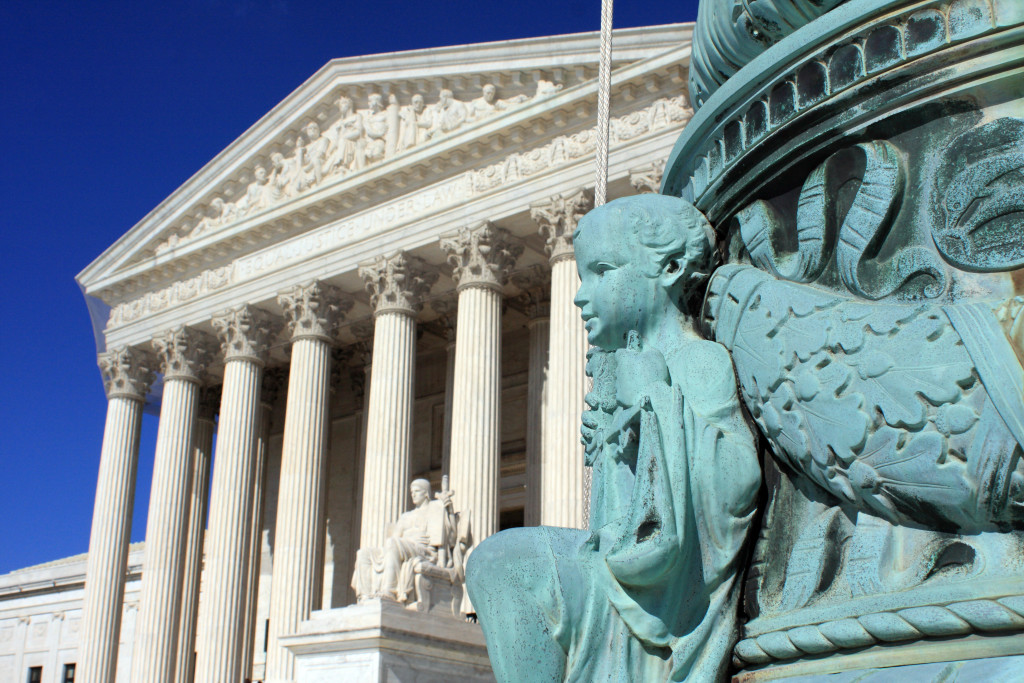Alabama Democrats criticize proposed new districts

Black lawmakers in the Alabama Legislature are criticizing new district lines that were drawn after a federal court ruled the Republican majority relied too heavily on race in crafting them the first time. Rep. John Knight, a Montgomery Democrat, said Thursday that the proposal is unacceptable. Federal judges in January ordered lawmakers to redistrict after ruling that 12 districts were gerrymandered. The ruling came after the Legislative Black Caucus filed a lawsuit, saying African-Americans were “stacked and packed” into designated districts. Knight said lawmakers could land back in court if a compromise isn’t reached. Reapportionment Chairman Sen. Gerald Dial said the map corrects the problems found by the court. One sticking point could be partisan control of Jefferson County. Democrats want an even split. Republicans would hold the majority under their proposal. Republished with permission of The Associated Press.
Supreme Court seems concerned over race in redistricting

The Supreme Court seems concerned that race may have played too large a role in the drawing of electoral districts in Virginia, to the detriment of black voters. Several justices hearing arguments in the case on Monday suggested a lower court failed to apply the correct standard when it upheld new boundaries for 12 state legislative districts. The case is the first of two redistricting disputes the court was considering. In the second case, the state of North Carolina is challenging a lower court ruling that struck down two districts as unconstitutional because they relied too heavily on race. The claim made by black voters in both states is that Republicans created districts with more black voters than necessary, making neighboring districts whiter and more solidly Republican. Republished with permission of the Associated Press.
U.S. Supreme Court to rule on use of race in redistricting

The U.S. Supreme Court agreed Monday to decide whether Republican lawmakers relied too heavily on race when they redrew North Carolina’s congressional districts to give the GOP a powerful advantage in the swing state. The justices will hear the case in the fall — almost certainly too late to affect November’s elections. But in the years ahead, it could impact partisan efforts to create electoral districts aimed at swaying the balance of power in Congress and in state legislatures. The Supreme Court could consider it together with a similar appeal from Virginia, where challengers say Republicans packed black voters into a dozen statehouse districts, strengthening GOP control of neighboring territories. Five of the eight current justices appear sympathetic to such claims brought by minority voters, based on a 2015 ruling in an Alabama case, according to election-law expert Rick Hasen at the University of California at Irvine. North Carolina’s GOP leaders deny factoring in race to an illegal extent, saying their 2011 map was designed primarily to give Republicans an edge while complying with the federal Voting Rights Act after the 2010 census. “We continue to believe the maps are fair, legal and constitutional and look forward to our day in court,” state Sen. Bob Rucho, a chief architect of the maps, said Monday. Opponents say they unfairly stacked black voters into two districts that were already electing African-American representatives, thus diluting their influence in neighboring territories. A federal court ruled in February that race was the predominant factor in drawing the two districts and ordered them redrawn. A new map of 13 congressional districts was used in an unusual June 7 primary, separate from most other races. A high court ruling also should influence a separate court challenge of North Carolina’s state legislative districts. North Carolina is a swing state whose voters split almost evenly in the last two presidential elections. But the GOP’s maps created veto-proof majorities in the state legislature, and the congressional delegation now has 3 Democrats to 10 Republicans. The latest court-ordered map essentially created a new district without an incumbent, but the Republican-leaning territory is expected to help the GOP maintain this 10-3 edge. It also upended the former territories of two Republican members of Congress, pitting them against each other in the primary. State Rep. George Holding beat state Rep. Renee Ellmers after groups including the Club for Growth and Americans for Prosperity funded ads questioning her conservative credentials. Holding is expected to beat a Democrat in November. The state’s lawyers, meanwhile, say the federal court’s logic forces North Carolina into the difficult situation of having to consider race to comply with federal voting rights laws, while also triggering “strict scrutiny” of its maps for doing so. “The three-judge court’s approach would trap states between the threat of vote dilution claims and the hammer of a racial gerrymandering claim,” they wrote in a Supreme Court filing. Their challengers argue that GOP mapmakers illegally gerrymandered the 2011 map, drawing boundaries “whose grasping tendrils were necessary to capture disparate pockets of black voters.” The case is McCrory v. Harris, 15-1262. Republished with the permission of The Associated Press.
A look at the redistricting process in every state

Districts for U.S. Congress and state legislatures are redrawn every 10 years after each U.S. census. In most places, that task is done by state lawmakers. Gerrymandering can occur when they draw boundaries that favor certain people or political parties, typically those already in power. To try to diminish the role of partisan politics, some states use appointed commissions for their redistricting duties. Those commissions have varying degrees of political independence from lawmakers. A look at how each state handles redistricting: ALABAMA Districts for Congress and the state legislature are drawn by state lawmakers, subject to a gubernatorial veto. ALASKA A 1998 amendment to the state Constitution created a five-person board to handle redistricting for state House and Senate seats. Two members are appointed by the governor and one each by the presiding officers of the House and Senate and the chief justice of the Supreme Court. Alaska has only one district for Congress. ARIZONA Districts for Congress and the state legislature are drawn by a five-person commission created by a voter-approved ballot measure in 2000. Twenty-five potential redistricting commissioners are nominated by the same state panel that handles appeals court nominees. The legislature’s two Republican leaders choose two commissioners from 10 Republican candidates, and the two Democratic leaders choose two from their party’s 10 nominees. Those four commissioners then select the fifth member, who must be an independent and serves as chairman. ARKANSAS A panel consisting of the governor, attorney general and secretary of state draws state legislative districts. Congressional districts are drawn by state lawmakers, subject to a gubernatorial veto. CALIFORNIA Districts for the state legislature and Congress are drawn by a 14-person commission, the result of voter-approved ballot measures in 2008 and 2010. A state auditor’s panel takes applications and selects 60 potential redistricting commissioners – 20 Democrats, 20 Republicans and 20 others. The state Assembly and Senate majority and minority leaders each can eliminate two nominees from each political category. Eight redistricting commissioners are randomly selected from the remaining pool of candidates. Those commissioners then select the six other members of the panel. It takes nine votes to approve the districts. COLORADO State legislative districts are drawn by an 11-member commission. The majority and minority party leaders of each legislative chamber each appoint one member, the governor appoints three and the chief justice of the Supreme Court appoints four. Congressional districts are drawn by the state legislature, subject to a gubernatorial veto. CONNECTICUT Districts for Congress and the state legislature require a two-thirds vote of approval from each state legislative chamber. If lawmakers fail to pass a plan, the task falls to a nine-member commission. The majority and minority party leaders of each legislative chamber each appoint two commissioners and the panel then picks its ninth member. DELAWARE State legislative districts are drawn by state lawmakers, subject to a gubernatorial veto. Delaware has only one congressional district. FLORIDA Districts for Congress and the state legislature are both drawn by state lawmakers. Congressional districts are subject to a gubernatorial veto. The legislative districts are not, but are automatically reviewed by the state’s Supreme Court. GEORGIA Districts for Congress and the state legislature are drawn by state lawmakers, subject to a gubernatorial veto. HAWAII Districts for Congress and the state legislature are drawn by a nine-person commission. The Senate president and House speaker each appoint two commissioners. The minority legislative party appoints two commissioners who, in turn, pick two more. The ninth commissioner is chosen by the other eight members of the panel. IDAHO Districts for Congress and state legislature are drawn by a six-member commission. The majority and minority party leaders in each legislative chamber each select one person to serve on the commission; the state chairmen of the Republican and Democratic parties also each select a commissioner. Two-thirds of the commissioners must vote to approve a map. Commissioners cannot be government officials or lobbyists. ILLINOIS Congressional districts are drawn by state lawmakers, subject to a gubernatorial veto. Lawmakers also are responsible for drawing state legislative districts, but if they fail, that task falls to an eight-member commission. The majority and minority leaders of each legislative chamber each choose two commissioners – one lawmaker and one citizen. If the panel fails to approve new districts by a majority vote, the state Supreme Court submits the names of two individuals from different parties and one is randomly chosen as a ninth member of the commission. An initiative proposed for the November ballot would shift congressional and state legislative redistricting to an 11-member citizens commission. INDIANA State legislative districts are drawn by lawmakers, subject to a gubernatorial veto. Lawmakers also are responsible for drawing congressional districts, but if they fail, the task falls to a five-member commission. The panel consists of the top-ranking lawmaker and redistricting committee chairman from each chamber, as well as a lawmaker picked by the governor. IOWA The nonpartisan Legislative Services Agency provides the legislature with a draft redistricting plan for both Congress and the state legislature. If lawmakers reject it, the panel submits a new plan. If legislators reject the second version, a third plan is prepared. But unlike the first two, the third version can be amended by lawmakers before they vote on it. KANSAS Districts for Congress and the state legislature are drawn by state lawmakers, subject to a gubernatorial veto. The state legislative plan is automatically sent to the state Supreme Court for review. KENTUCKY Districts for Congress and the state legislature are drawn by state lawmakers, subject to a gubernatorial veto. LOUISIANA Districts for Congress and the state legislature are drawn by state lawmakers, subject to a gubernatorial veto. MAINE A 15-member commission drafts redistricting plans for Congress and the state legislature and submits those to the legislature. Lawmakers can either enact those plans or approve their own plan by a two-thirds vote of each chamber. The House speaker and minority leader each appoint three members, and the Senate majority and minority leaders each appoint two to the commission.
Fight over legislative districts returns to district court
The fight over Alabama’s legislative districts is shifting back to Montgomery after a divided U.S. Supreme Court said a lower court must take another look at whether GOP lawmakers relied too heavily on race when they drew new district lines. James U. Blacksher, a lawyer for the Alabama Legislative Black Caucus, which filed the lawsuit against the plan, said they will fight to have the legislative districts redrawn after the case officially gets back to federal court next week. The caucus this past week presented a map of proposed new lines, which Blacksher said should be a starting point for negotiations. “Ultimately we are going to have to have another election,” Democratic Sen. Rodger Smitherman of Birmingham said. “It’s going to be difficult, if not impossible, to do what the court said without having new elections.” The Alabama Democratic Conference and the Alabama Legislative Black Caucus had challenged the lines that were the drawn in 2012 under the newly elected GOP legislative majority. The U.S. Supreme Court last month reversed a lower court ruling that upheld the plan, saying the court did not properly consider complaints that state officials illegally packed black voters into too few voting districts. Justices said the lower court should have looked at claims of racial gerrymandering on a district-by-district level, not just statewide. The Supreme Court majority also said Alabama took a position of prioritizing racial targets when drawing districts. Instead of asking how it could maintain the minority percentages in districts, justices said, the court should have asked what percentages the minority should have to elect their candidate of choice. “The issue now will be whether the plaintiffs proved any of these districts were drawn predominantly on race,” Alabama Solicitor General Andrew Brasher, who handles appellate litigation for the state. Brasher predicted that the map would ultimately be upheld. “The district court said there are a lot of other reasons to draw the lines that way.” Republicans said their plans complied with the voting rights law by preserving all the districts in which blacks were a majority and adjusting populations so that districts contained about the same number of people. The new plan allowed only a 2 percent population difference between districts, a much lower variance than previous plans. Black lawmakers said the new lines resulted in the “stacking and packing” of black voters into designated minority districts, limiting minority voters’ ability to influence elections elsewhere. Justices put a spotlight on Senate District 26, a district that includes most of the majority-black neighborhoods in Montgomery. “Of the 15,785 individuals that the new redistricting laws added to the population of District 26, just 36 were white — a remarkable feat given the local demographics,” justices wrote. The Supreme Court majority, in its opinion, said, “There is strong, perhaps overwhelming, evidence that race did predominate as a factor when the legislature drew the boundaries of Senate District 26.” “It was so obvious and so blatant what happened,” said Quinton Ross, the senator from Senate District 26. Plaintiffs said the doubt raised by justices over that specific district is a strong indicator that they will prevail on remand. “There will be a big ripple effect,” Blacksher said. “The problems they identified in Senate District 26 are identical to those in the other districts.” GOP legislative leaders said they think their map will ultimately be upheld. “I’m confident at the end of the day, district lines are going to stay like they are,” said Speaker of the House Mike Hubbard, an Auburn Republican. Republished with permission of The Associated Press.


